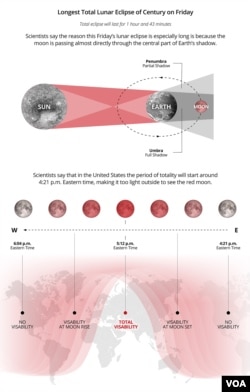Scientists say the longest total lunar eclipse of this century will grace the night sky on Friday, turning the moon a reddish color.
NASA says the lunar eclipse will last for 1 hour and 43 minutes with total viability in Eastern Africa and Central Asia. Residents in most of the world will be able to see at least a partial eclipse. However, it won’t be visible from North America.
Scientists say that in the United States the period of totality will start around 4:21 p.m. Eastern time, making it too light outside to see the red moon.
During a lunar eclipse, the moon appears to be red because it lines up perfectly with the Earth and sun such that the Earth's shadow totally blocks the sun's light. The moon loses the brightness normally caused by the reflection of the sun’s light and takes on an eerie, reddish glow, giving the lunar eclipse moon the nickname of blood moon.
Scientists say the reason this Friday's lunar eclipse is especially long is because the moon is passing almost directly through the central part of Earth’s shadow. To compare, it falls just 4 minutes shy of the longest possible time a lunar eclipse could last.
For those who aren’t able to see the lunar eclipse this month, July has another treat in store for skygazers when Mars makes a close approach to Earth. Mars will appear about 10 times brighter than usual the last few days of the month, with peak brightness occurring on July 31.
Everyone in the world will have the possibility to see this celestial phenomenon, providing the skies are clear.










